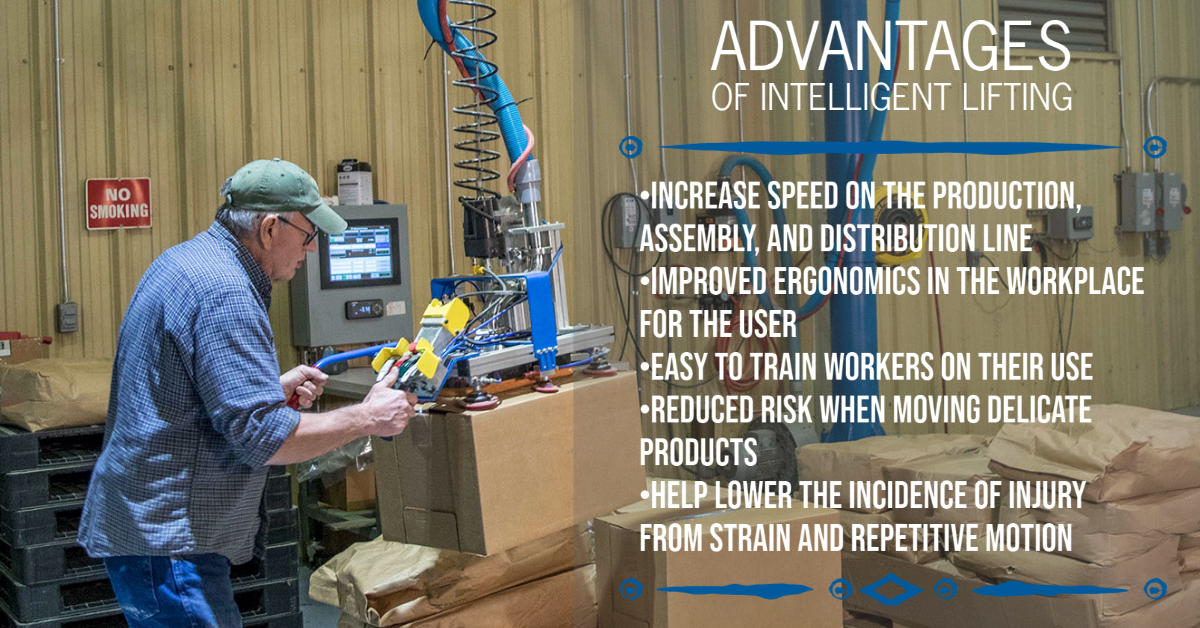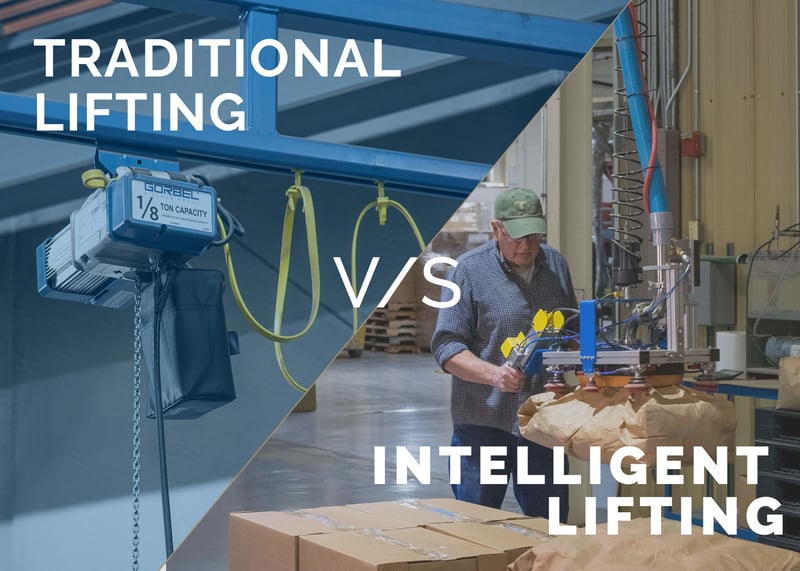What Are Intelligent Lifting Devices (ILDs)?

Many warehouses augment their labor force's ability to quickly, safely, and efficiently handle materials through the use of Intelligent Lifting Devices (ILDs). If you don't know what ILDs are already, you will soon. They are quickly becoming a mainstay in the materials handling industry.
At the most basic levels, Intelligent Lifting Devices are ergonomic handling equipment that augments the user's lifting capabilities with servo drive systems. ILDs can take a variety of forms, but one key feature is that they are ergonomic. ILDs behave like a natural extension of the worker's arms and hands. Intelligent Lifting Devices use sensing technology, which allows them to translate the user's force into precise movements.
The applications for ILDs are nearly limitless in the manufacturing, distribution, and assembly industries. Intelligent Lifting Devices are being incorporated in factories and warehouses to assist the human labor force with repetitive, difficult, or time-consuming lifting and moving tasks. As more and more people see the technology in action, they are finding ways to put it to work on their own material handling needs.
What Are the Operational Efficiency Advantages of ILDs?
Increase Speed on the Production, Assembly, and Distribution Line
ILDs move as fast as the operator wants them to move. Enabling workers to move even heavy, awkward items much faster than before. Since the speed is variable, ILDs are also great for operations where workers need to move quickly at some points and slower at others. The Intelligent Lifting Device empowers the worker to increase their pace and provide greater efficiencies on the line.
Users can also program some ILDs to return automatically to the start position. This eliminates the time the user would need to spend putting the tool back "home" after each use. They can instead focus their attention on the next task while the ILD readies itself for its next use. That can eliminate wasted time on the job and vastly speed up production times.
Improved Ergonomics in the Workplace for the User
ILDs act as a natural extension of the worker's arms and hands. The devices seamlessly integrate into the workstation, providing a safer way for the worker to do their job. Improved ergonomics translate to higher production numbers with fewer accidents and injuries.
The devices also offer automatic weight compensation. If users need to pick up items in a variety of weight classes, the Intelligent Lifting Device will automatically adjust to compensate for the weight. That means users get the same benefits no matter how much weight they are lifting and there is no need to stop and reprogram the device.
Easy to Train Workers on Their Use
Because ILDs are ergonomic in nature and respond to the user's intent, training on the devices takes only minutes. Users will be able to put the new machinery to work almost immediately. That means there is little downtime for training and managers see improvements to productivity right away.
Quick training times give ILDs another operational efficiency advantage: worker acceptance. Because of their seamless integration into the workstation and ease of use, workers are far more likely to put ILDs to work than traditional lifting devices. That means capital invested in the systems won't go to waste. If workers decide they don't like to use a lifting device, they put themselves at greater risk of injury by working around it. Not only is it a waste of time and resources, but unused lifting equipment can also result in more downtime. Worker acceptance of Intelligent Lifting Devices is high and is a key factor in their success in the materials handling industry.

Reduced Risk When Moving Delicate Products
The computer sensors inside the ILDs provide precise, controlled movement. That helps the user guide delicate machinery into place, even if it's heavy or awkward. The controlled movements and variable speeds mean workers can move as slowly as needed to get products into place. This gives a big advantage when it comes to positioning delicate machinery.
Controlled movements mean there is less risk of user error and accidental damage to materials. It's human error that's responsible for most of the damage that happens in production or during pick and pack. An automation hybrid like an ILD helps reduce that risk. Lower shrinkage means a healthier bottom line.
Help Lower the Incidence of Injury from Strain and Repetitive Motion
Repetition and strain injuries are two of the most common causes of worker injury in the materials handling environment. ILDs can greatly reduce the risk for workers, giving them the means of performing difficult tasks safely. That means fewer workers' compensation claims, fewer sick days, and higher productivity (not to mention happier, safer workers).
Intelligent Lifting Devices help to reduce the risk of strain by compensating for the weight of the item. Assembly Magazine notes that the Gorbel® G-Force® Intelligent Lifting Device makes a 150-pound load feel like three pounds. That means users don't need to stress their musculoskeletal system to move heavy loads into place.
The Pros and Cons of ILDs versus Traditional Lifting Devices

ILDs are safer, faster, and more user-responsive than traditional handling devices. While the benefits are numerous, it's important for individual warehouses and manufacturers to carefully weigh the pros and cons of putting these devices on the line.
- Intelligent Lifting Devices will likely require a larger up-front capital investment than traditional handling devices. It's certainly a factor that every warehouse manager will need to take into account. However, it's important to look at the long-term cost benefits of ILDs when weighing the pros and cons. ILDs can help boost productivity and decrease worker sick days, meaning that they could very quickly end up paying for themselves. Like all technology, the cost of ILDs will likely continue to come down in the future. However, investing in Intelligent Lifting Devices now could give a forward-thinking warehouse an advantage in a crowded market.
- Like any new technology, ILDs require time to implement in a warehouse. While that's a con for anyone looking at their downtime numbers, ILDs are very quickly implemented when you work with an experienced manufacturing and installation team. They can install devices quickly and train users in minutes. Intelligent Lifting Devices are also a midway point between human labor and full automation. EHS Today notes that the hybrid of human user and automation offers "the advantages of reduced cost and greater flexibility than total automation."
If you are curious about the benefits of bringing ILDs to your warehouse, check out this case study from the Rochester Institute of Technology.
Finding the Right Features of Benefits for ILDs
There is no one-size-fits-all Intelligent Lifting Device solution for materials handling. Which device, where it's installed, and how it's used will all depend on the individual application needs. That's why it's important to consider all the ILD options and carefully weigh the features and benefits. Then you can determine which device is right for your material handling needs. Gorbel® offers several customizable Intelligent Lifting Device solutions for the material handling industry, offering benefits such as:
- Anti-recoil technology
- Infinite speed control
- Fail-safe load braking in case of power loss
- Four times faster than traditional lifting devices
- Built-in photosensor to ensure operator presence
- Capacity overload system prevents excess loads
- Full-stroke mode allows users to carefully position materials
- Precision controls so users can get delicate parts into place
The G-Force® Intelligent Lifting Device
Gorbel® offers an Intelligent Lifting Device that adapts to a variety of environments, the G-Force® . Gorbel® offers G-Force® options for higher capacities, faster speeds, and more responsive performance. That way you can get the device that's needed to get the job done. This lifting device is ideal for applications in the automotive industry, heavy equipment manufacturing, parts assembly, repetitive lifting tasks, and much more.
The Easy Arm®

The Easy Arm® is an intelligent lifting arm that uses the G-Force® device in combination with an articulated jib crane. This is a great option for smaller workspaces looking for a plug-and-play solution. The units are ready to install when shipped and simply bolt to the floor. That makes them easy to reposition in the future, too, if the needs of your materials handling team change. These Easy Arm® systems are especially useful if users need to reach around obstructions, work overhead, or unload machined parts.
Ready to implement technology into your warehouse that can help you achieve your operational efficiency goals? Talk to the Gorbel® ILD team to learn more about which Intelligent Lifting Device may be right for your materials handling needs. Get in touch with us today by giving us a call at 1-844-268-7055 or filling out the form on our contact page.